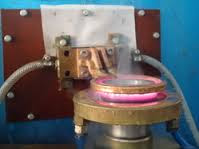Induction hardening is a form of heat treatment in which a metal part is
heated by induction heating and then quenched. The quenched metal undergoes a marten’s
tic transformation, increasing the hardness and brittleness of the part.
Induction hardening is used to selectively harden areas of a part or assembly
without affecting the properties of the part as a whole.
Process
Induction
heating is a non contact heating process which utilizes the principle of
electromagnetic induction to produce heat inside the surface layer of a
work-piece. By placing a conductive material into a strong alternating magnetic
field, electric current can be made to flow in the material thereby creating
heat due to the I2R losses in the material. In magnetic materials, further heat
is generated below the Curie point due to hysteresis losses. The current
generated flows predominantly in the surface layer, the depth of this layer
being dictated by the frequency of the alternating field, the surface power
density, the permeability of the material, the heat time and the diameter of
the bar or material thickness. By quenching this heated layer in water, oil, or
a polymer based quench, the surface layer is altered to form a marten’s tic
structure which is harder than the base metal.
Definition
A
widely used process for the surface hardening of steel Induction hardening. The
components are heated by means of an alternating magnetic field to a
temperature within or above the transformation range followed by immediate
quenching. The core of the component remains unaffected by the treatment and
its physical properties are those of the bar from which it was machined, whilst
the hardness of the case can be within the range 37/58 HRC. Carbon and alloy
steels with equivalent carbon content in the range 0.40/0.45% are most suitable
for this process.
A
source of high frequency electricity is used to drive a large alternating
current through a coil. The passage of current through this coil generates a
very intense and rapidly changing magnetic field in the space within the work
coil. The work piece to be heated is placed within this intense alternating
magnetic field where eddy currents are generated within the work piece and resistance
leads to Joule heating of the metal.
This
operation is most commonly used in steel alloys. Many mechanical parts, such as
shafts, gears, and springs, are subjected to surface treatments, before the
delivering, in order to improve wear behavior. The effectiveness of these
treatments depends both on surface materials properties modification and on the
introduction of residual stress. Among these treatments, induction hardening is
one of the most widely employed to improve component durability. It determines
in the work-piece a tough core with tensile residual stresses and a hard
surface layer with compression stress, which have proved to be very effective
in extending the component fatigue life and wear resistance.
Induction
surface hardened low alloyed medium carbon steels are widely used for critical
automotive and machine applications which require high wear resistance. Wear
resistance behavior of induction hardened parts depend on hardening depth and
the magnitude and distribution of residual compression stress in the surface
layer of Induction hardening Faridabad.





